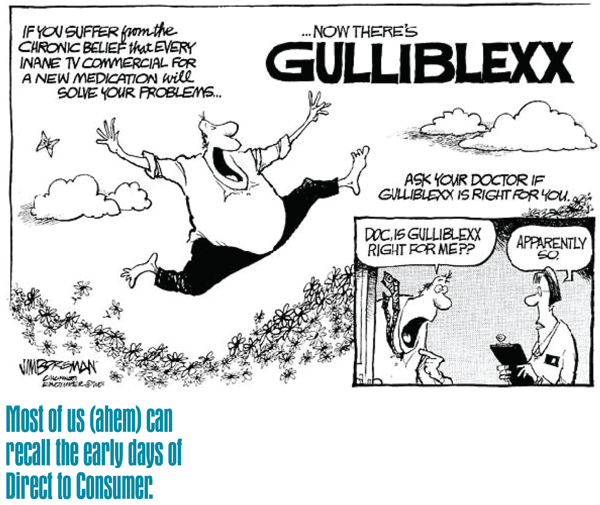Most of us (ahem) can recall the early days of Direct to Consumer marketing.
Things were simple: It was easy to be a consumer and easy to be a pharma marketer, right? In 1981 Merck published the first DTC ad for a prescription medication, Pneumovax, in Reader’s Digest. Or in 1983, Boots Pharmaceuticals aired the first televised DTC ad, for Rufen (prescription strength ibuprofen). These marketers were pioneers, absolutely, but their choices of media were straightforward and their ability to get the consumer’s attention was a given. Create the need, direct the consumer to “talk to your doctor.” And you’re done.
This resulted in a “spend more, get more” strategy that worked for a while. Now, not so much.
The Patient is Engaged. Let’s Build On This.
Fast forward to 2012, when Leonard Kish stated, “The engaged patient is the blockbuster drug of the century,” to near unanimous agreement.
Now, newly diagnosed patients with diabetes, cancer, rheumatoid arthritis or psoriasis—it doesn’t matter which—have at their fingertips an overabundance of “educational materials.” The HCP has unprecedented new demands on their time—the detail rep has (maybe) 60 seconds per HCP visit. Yet the ACA is requiring new standards of accountable care and rigorous new levels of patient engagement.
It’s happening fast. Kevin Pho said earlier this year, “The patient is the most important part of the medical team.” Was he right?
Whoa. In a few short decades we went from Marcus Welby, MD to the self-diagnosing, all-knowing, Google Scholar-quoting fully engaged patient?
Well, yes and no. How we, as healthcare marketers understand, learn and apply new thinking will help everyone.
But how do we effectively “reduce the randomness” of what’s out there, to quote Dr. Steven E. Come, Medical Oncologist at Beth Israel Deaconess Medical Center. How do we leverage the channels available—TV, print, point of care, digital, community, mobile, peer to peer—to best engage and educate this new discerning and smarter patient? How do we help deliver what they are asking for?
The Patient’s Medium is the Message
This is a slightly modified version of Marshall McLuhan’s assertion from (incredibly) 50 years ago that resonates even more now. The way that today’s patient experiences media demands that we take a new approach. Binge-watching House of Cards doesn’t allow for the traditional (and expensive) 60-second spot to be involved in the viewing experience. If it was there, the patient would discount it as a nuisance anyway.
Does the patient really want to be reminded of their condition while they are scrolling through their friends’ lives on Facebook? No. Or looking through their cousin’s wedding pictures on Instagram? No.
So what to do?
It’s not that patients aren’t interested in seeing or viewing or experiencing pharmaceutical product advertising—exactly the opposite. After 20 years they expect it. It’s just that they want it to resonate with their personal lives and their personal experiences. Today’s consumer, the patient we care deeply about, is in control of their media. That means: What they experience, when they experience it, where they experience it, and how they experience it. And the bottom line? Can they trust it?
“Reaching the right individual at the right time with the right/appropriate message…that will lead to an informed dialogue with their trusted healthcare professional about their condition.” That is what the newly empowered patient demands—and that is what we must deliver.
Fact: Patients Trust Their HCP (Teams)
The HCP is still the single most trusted source for the patient and that relationship is still the most important in all of healthcare. In Gallup’s recent ranking of the most trusted professions, nurses, doctors and pharmacists are the “Top Three.”
“Trust is one of the central features of patient-physician relationships,” according to the Journal of General Internal Medicine. And Consumer Reports recently reported, “Patients are healthier when they have a consistent relationship with a physician.”
Let me add a caveat. It’s now the healthcare team who reigns in trust and importance. The physician, the nurse practitioner, the physician assistant, the diabetes educator, the pharmacist, the oncology nurse navigator, even the hospital system/ACO patient liaisons are all collaborating to provide the best care we have ever seen in this country. Quality measures are increasing and patient-reported outcomes are improving.
“Healthcare is still defined as one sick person who is compassionately cared for by another,” says Andrew Sussman, MD, Senior Vice President, Associate Chief Medical Officer, CVS Health.
A Patient’s Journey Today is the Patient Experience
Let’s take into account the journey of a formerly obese patient in his mid-40’s—call him patient John—to understand how DTP marketing can best reach and influence this newly engaged and empowered patient.
For a decade, John’s lifestyle and weight increased in parallel. Nearly 300 pounds, John could not keep up with his three children. John heard from everyone, his wife, his friends, co-workers—all nudging him to “do something.” John didn’t notice the ads on TV and ignored the ads he saw in his weekly sports magazine thinking, “This isn’t for me!”
Things changed during a routine consultation with his physician and her healthcare professional team. John trusted his doctor and he felt comfortable with the nurse practitioner who took time to talk with him. That day, John was motivated to open up and talk with his HCP team after taking a few minutes in the waiting room to read an uplifting, unbiased and hopeful story about someone like himself—who had turned his life around. He noticed that the magazine was reviewed by his physician’s specialty society and a leading patient advocacy organization, which gave him even more trust and comfort.
John was diagnosed with diabetes that day. During the consultation in the exam room, he experienced several other patient engagement tools. The first was a compelling poster that provided a “teachable moment” about obesity, which empowered him by providing questions he could ask during the visit. John and the diabetes educator took the time to review a digital tablet and he watched real stories of real patients—call it authentic storytelling. The stories offered John hope and insight into how to manage his condition. The diabetes educator then emailed John a few stories right from the tablet to read and review later, and included a medication adherence tool that he could also download on his smartphone later.
For the first time, John was enthusiastic. His trust in what he learned, and how he learned it, led him to take the patient education materials he found in the waiting room and share them with his friends and family noting, “This might be helpful to you.” He also shared the “halo effect” of his trusted visit to his HCP. John’s trust in his HCP team—through various levels of patient education—even led him to nominate his nurse practitioner for a national award for her life-changing work.
What is There to Learn From This?
All of this type of patient engagement is here—now—and happening. Every aspect of how this patient was engaged through DTP is in place. It all makes a positive difference in patients’ lives and in the ROI of the brands that employ these tools.
Some guidelines to consider in the new world of DTP:
- None of this would have happened without the inherent trust in the media and the message. DTP marketers have to make sure that the content they are involved with is unbiased, approved and vetted by HCP and patient advocacy organizations.
- Content can be uplifting and hopeful while remaining clinically accurate and useful. Adherence research shows that high-quality, trusted content can “carry forward” for days, weeks and months.
- Personal stories—or authentic storytelling—is key to a high level of patient engagement, whether in print, video or interactive.
- Surround the patient with messaging, make it relevant and fully integrated so that it makes sense to the patient. Disjointed messaging results in a disconnect and a breakdown of trust.
- This means employing interactive materials, too. This patient will now manage his condition through a “digital app prescription” from his HCP—not from a random Internet search.
- The brand should be part of the solution. Because of the trusted environment and the quality of the patient education, the branded ad in the magazine and on the TV at point of care are perceived as useful, providing the patient with a solution to help manage his care.
To sum it up, I couldn’t have said it better than the National eHealth Collaborative (NeHC):
The “Patient Engagement Framework” is defined as a continuum of patient-engagement steps that align with the federal EHR Meaningful Use Incentive program. It’s goal: Informing, engaging, empowering, partnering and supporting patients in the community.







